

Digital Government and Smart Cities

The remarkable advantages and great potential of large-scale models in natural language recognition, understanding, decision-making, and content generation have become the core driving force for a new round of scientific and technological revolution and industrial transformation. Through the combination with thousands of industries, we will promote the leapfrog development of intelligent, high-end, and green industries. As big models have become a new field of competition in various countries, the state, provinces, and cities have introduced incentive policies to promote the application of large-scale models in the fields of government affairs, finance, justice, enterprise digital transformation, etc., to build more convenient, intelligent business consulting, auxiliary decision-making, digital assistants, film and television production, and other innovative business scenarios, which will help thousands of industries explode their productivity, upgrade their business models, and promote high-end and efficient development of the intelligent economy.

1. Application in industries: With the data accumulation and business experience of Beiming Software in the fields of government affairs, finance, justice, transportation, and other industries, we have dabbled in application scenarios such as digital assistants, business consulting, urban governance, policy matching, transportation planning, and industrial decision-making and promoted the application of large-scale models in the industry field.
2. Multi-modal information fusion analysis: Using multi-modal large model speech conversion, image recognition, multi-modal fusion, and other technologies, our solution can improve human-computer interaction, intelligent matching, risk identification, automatic warning, and other functions to comprehensively optimize the user experience.
3. Various technical tools and algorithms: In response to the needs of business scenarios, we provide tools such as RAG, KAG, Chat2BI, and process robots to help users build an industry knowledge base, make up for the shortcomings of the large-scale big model in deployment in industries, and establish a closed-loop of AI services from business perception, analysis, inference, to action.
4. Build a large model service ecosystem with leading companies: We have established strategic cooperation with Baidu, Smart Spectrum, Huawei, and other large-scale model leaders to integrate the vendors' basic big models, arithmetic resources, and pre-training capabilities with the industry business, and to accelerate the application of large-scale models in the financial, manufacturing, governmental, judicial, entertainment, and other sectors.

The application architecture of the large-scale models in the industries mainly includes infrastructure, data, development framework, and application scenarios:
1. Infrastructure: computing power, storage, network, and other facilities. The large-scale model has high requirements for computing power and storage, and it is necessary to configure dedicated GPU servers and storage devices.
2. Data resources: We integrate and process various types of industry data resources from various channels such as government websites, social media platforms, Internet encyclopedia knowledge, books, public databases, and business systems, and build industry databases to provide rich industry knowledge for large-scale models.
3. Large-scale models and tools: Privatized deployment of multimodal large-scale models and combination with vector database, retrieval enhancement, knowledge enhancement, application scenario Agent, tasking, and other technical tools and external Internet services. We’ve built a development framework for large-scale models of government affairs, providing natural language understanding, knowledge query, data statistical analysis, system integration, transaction visualization, and other technical support capabilities for upper-level applications.
4. Application scenarios: Integrate model capabilities with government services, urban governance, emergency command, business assistance, cultural tourism, and other businesses to create innovative application scenarios such as "intelligent customer service, intelligent business assistants, intelligent video recognition, event prediction and early warning, industrial economic analysis, and government instant batch processing" to provide users with a more convenient, accurate and personalized service experience.
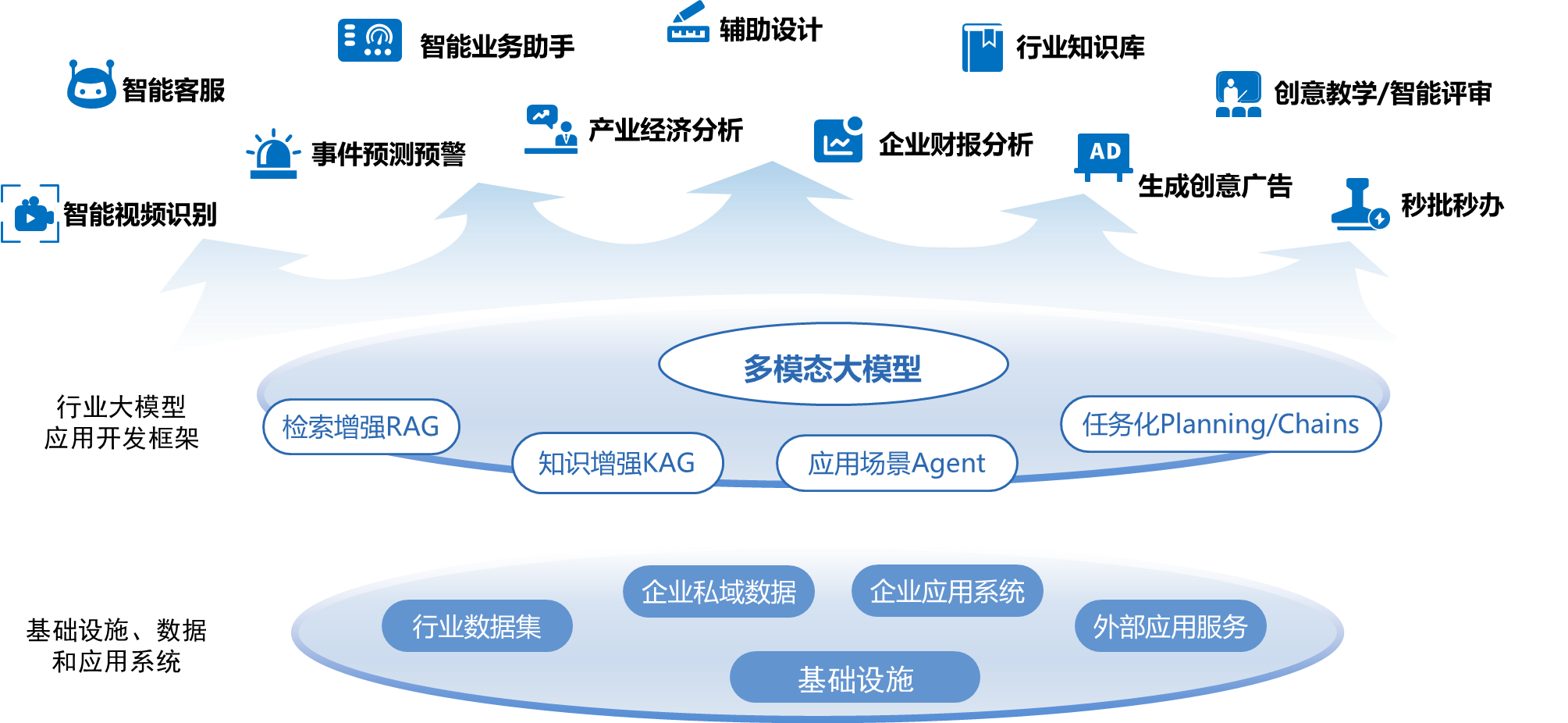

The solution promotes the implementation of large-scale models in industries, which is beneficial to accelerating the deepening application of AI technology in industries. It can also empower business innovation and realize the intelligent upgrading of business models.
(1) Using the powerful natural language analysis and understanding capabilities of large-scale models, the system can accurately grasp and quickly respond to user needs, and establish a new mode of human-computer interaction based on natural language question-answering, which brings a more humanized, intelligent, and convenient business experience.
(2) Large-scale models can quickly query relevant content from massive data and generate accurate answers, replacing a large number of simple and time-consuming manual tasks of information retrieval and analysis. It can help staff devote their limited time and energy to more valuable work.
(3) As a unified service portal, the large-scale model connects with application systems in various industries, transforms user needs into automated business processes, flexibly invokes relevant functions and services between systems, forms an efficient, interconnected, intelligent, and convenient cross-departmental business collaboration mode, upgrades the one-stop service experience, and promotes cross-disciplinary business innovation.
(4) By combining itself with industry businesses, the large-scales model can tap deeper knowledge associations, fully integrate into existing business scenarios, realize the optimization and overhaul of business processes and service methods, and form a new normal of "proactive", "personalized", and "intelligent" services.

1. Intelligent Customer Service for Government Affairs: Innovative applications of intelligent customer service for government affairs are built based on the large-scale model, which can provide government affairs services such as government affairs consultation, appointment handling, auxiliary form filling, and chatting. Through a simple Q&A, the large model can quickly identify user needs, give targeted answers, and flexibly respond to various complex scenarios. With the dialogue context, the deep-seated needs of users can be excavated, and more recommendation schemes or related questions are given. The large-scale model can also adjust the tone and content of its answers according to the user's preferences and language style, resulting in a more personalized and user-friendly service experience.
2. Policy Intelligent Q&A: Provide intelligent Q&A services for enterprise-favorable policies based on the large-scale model. Using technologies such as prompt words and search enhancement, the large-scale model can quickly locate policy key points and related information from the policy database and ultimately generate accurate and comprehensive answers to questions, greatly improving the convenience and efficiency of enterprises in obtaining policies. At the same time, the old operation method of relying on the mouse and keyboard will be replaced by a one-question-one-answer approach, resulting in a simpler and more pleasant human-computer interaction experience for enterprises.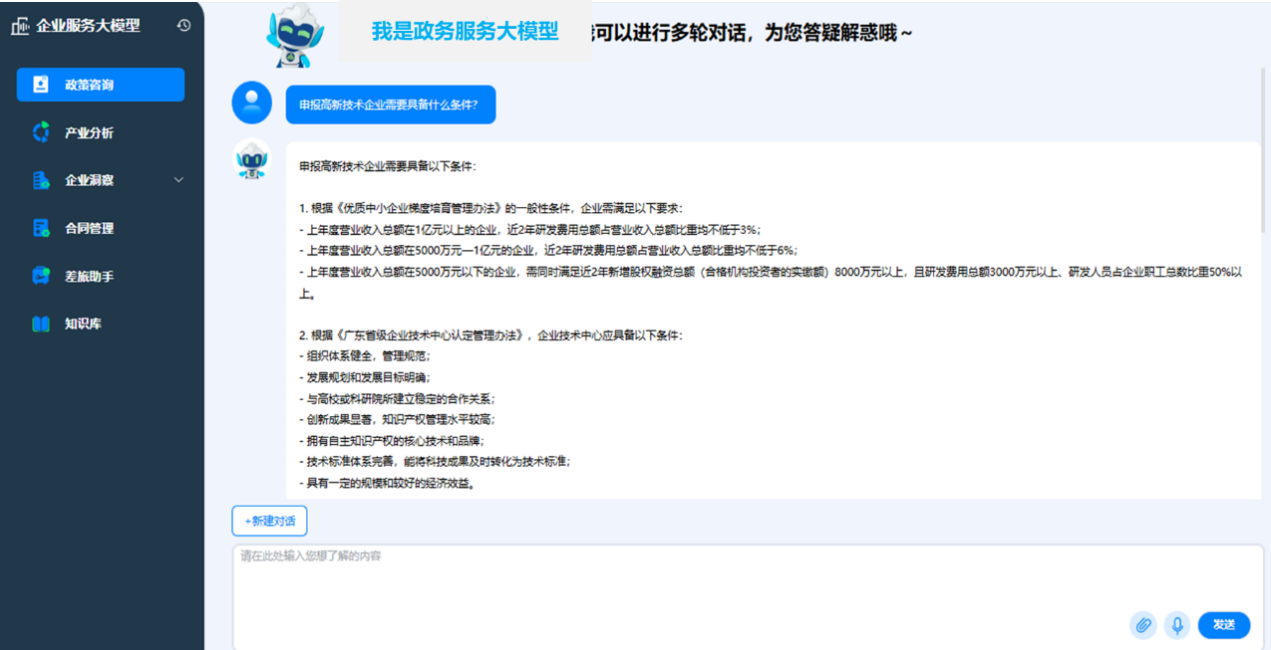 3. Industrial economic analysis: Innovate economic data statistics and analysis work based on the large-scale model and provide natural language question-answering data analysis services. Traditional industrial economic data analysis often requires a pre-set model and a series of parameter configurations in the auxiliary decision-making system. By inputting query conditions, the corresponding analysis chart can be generated. The process is relatively complex and the chart style cannot be changed. The use of the large-scale model for industrial economic analysis does not require such complex system operations. Just through dialogue, the model can understand user needs and automatically query and analyze relevant databases or existing system data, and then quickly generate economic analysis charts with drawing tools to flexibly meet the analysis needs of different users and transform the traditional customized business model into a more efficient, convenient, and personalized data analysis method.
3. Industrial economic analysis: Innovate economic data statistics and analysis work based on the large-scale model and provide natural language question-answering data analysis services. Traditional industrial economic data analysis often requires a pre-set model and a series of parameter configurations in the auxiliary decision-making system. By inputting query conditions, the corresponding analysis chart can be generated. The process is relatively complex and the chart style cannot be changed. The use of the large-scale model for industrial economic analysis does not require such complex system operations. Just through dialogue, the model can understand user needs and automatically query and analyze relevant databases or existing system data, and then quickly generate economic analysis charts with drawing tools to flexibly meet the analysis needs of different users and transform the traditional customized business model into a more efficient, convenient, and personalized data analysis method.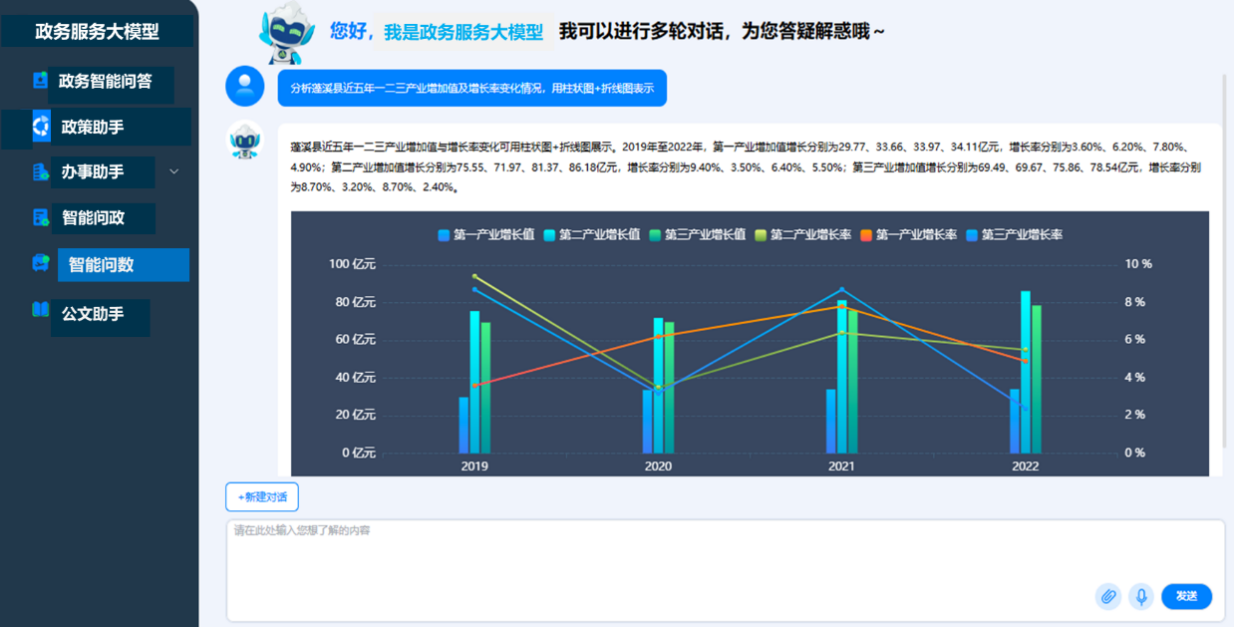
4. Document assistant: We’ve built a "document assistant" based on the large-scale model, which can help government staff quickly inquire about desired documents, meeting minutes, or leaders' speeches from a large number of historical documents, greatly saving data inquiry and collation time and further improving work efficiency. At the same time, the large-scale model can also analyze, collate, refine, and summarize multiple documents to quickly generate content summaries or basic reports and provide staff with summary and more targeted reference materials.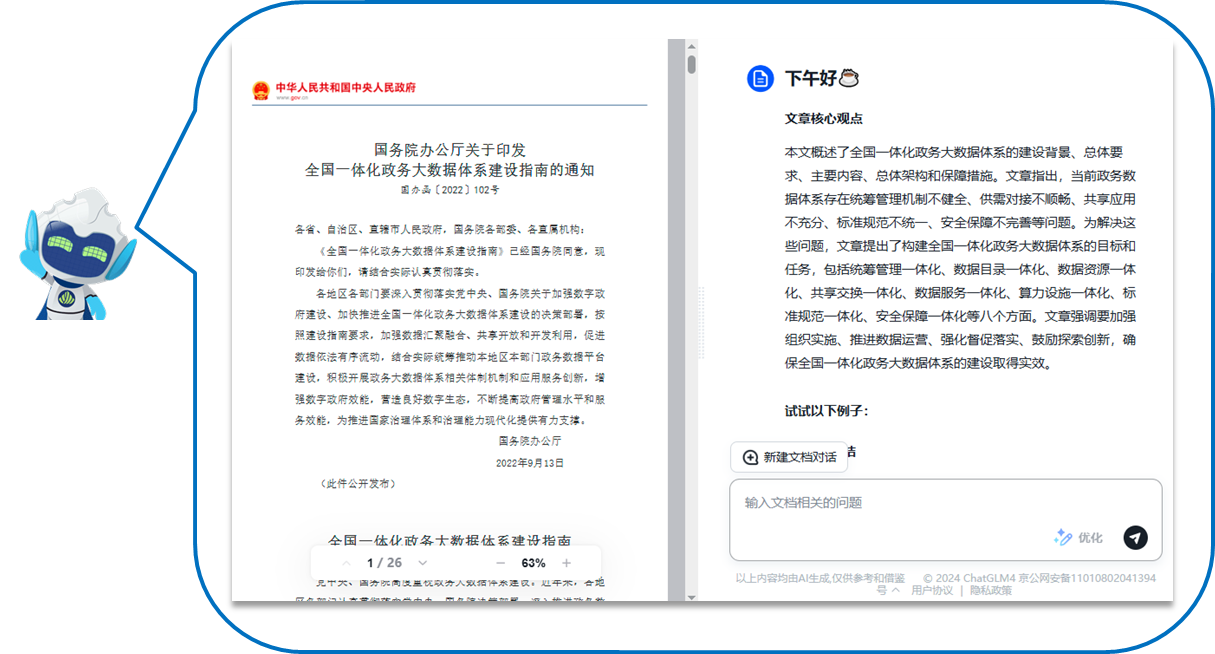
5. Intelligent identification of urban events: Traditional intelligent identification requires the deployment of fixed AI algorithms for urban surveillance cameras and can only monitor for a certain type of problem. The monitoring scope and objects are relatively limited. As for the identification of urban violations that is based on the multi-modal large-scale model, there is no need to bind fixed algorithms for cameras, and the existing knowledge of the large-scale model can be used to quickly identify and accurately study one or more violations, such as "illegal parking, roadside stall business, pavement garbage, drying clothes along the streets, illegal operation on the construction site, and mud spilling", etc. The identification has wider scope, faster speed, higher accuracy, and it is easier to promote and apply, greatly improving the efficiency and intelligent level of the city's integrated governance.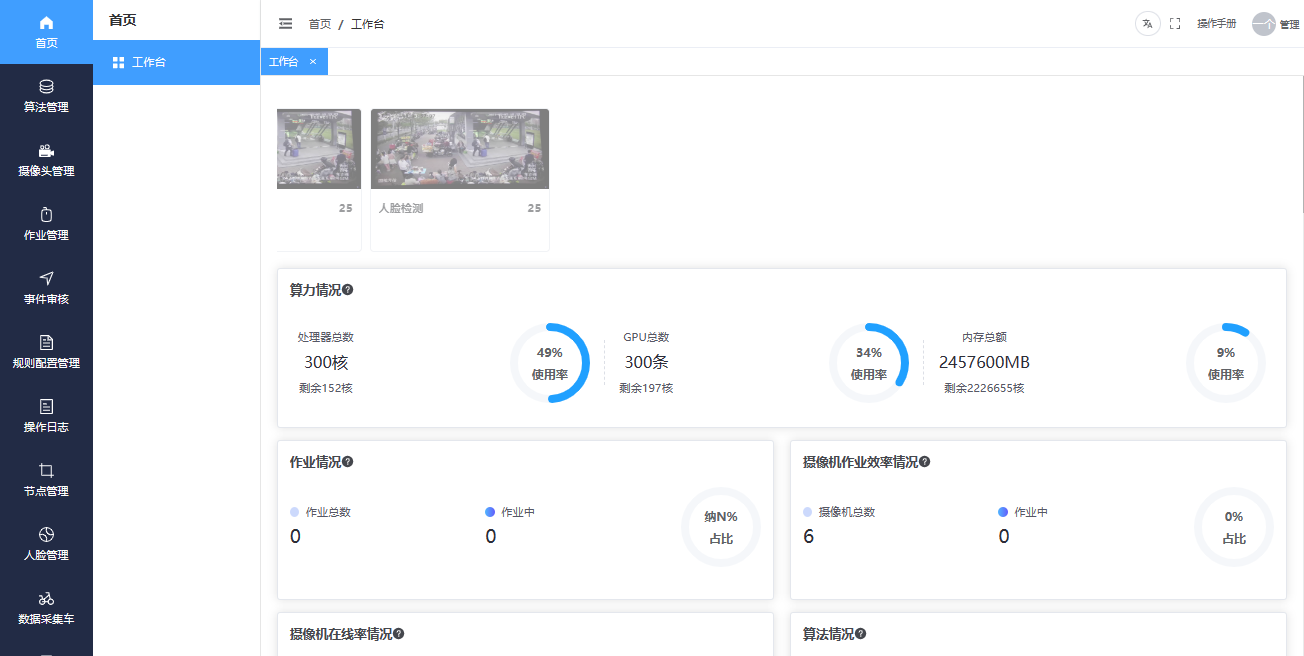

Shenzhen Minsheng Police Artificial Intelligence Platform
Government Affairs Artificial Intelligence Platform of Changsha City, Hunan Province
Government Affairs Artificial Intelligence Platform of Wangcheng District, Changsha City, Hunan Province
Prosecution Process Robot (Digital Prosecutor), People's Procuratorate of Binzhou City, Shandong Province
Artificial Intelligence Platform for Smart City of Wugang City, Henan Province
Awards:
"Key Technologies and Applications for Rapid Retrieval and Deep Analysis of Massive Video Content" received the First Prize of Guangdong Science and Technology Progress Award
"Intelligent Medical Image Analysis Research and Clinical Application Demonstration" won the Second Prize of Guangdong Province Science and Technology Progress Award.